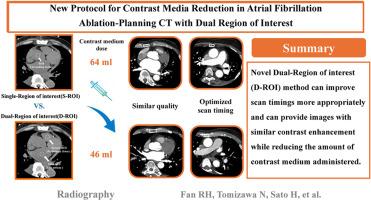New protocol for contrast media reduction in atrial fibrillation ablation-planning CT with dual region of interest
IF 2.5
Q2 RADIOLOGY, NUCLEAR MEDICINE & MEDICAL IMAGING
引用次数: 0
Abstract
Introduction
Many patients with atrial fibrillation have impaired renal function, and therefore pre-operative CT for radiofrequency catheter ablation should minimize the use of contrast media. This study describes a dual-region-of-interest (D-ROI) protocol for the scanning of pulmonary veins and left atrium (PVs-LA) with less contrast media and optimized scan timing compared to the single-region-of-interest (S-ROI) protocol, without compromising image quality.
Methods
This study retrospectively included 100 patients who underwent PVs-LA CT between July 2019 and February 2022. The participants were divided into two groups: Those scanned using the S-ROI method (Group A, n = 50), and those scanned using the D-ROI method (Group B, n = 50). Descriptive statistical analysis of the contrast effect and scan timing was performed using quantitative and qualitative data collected from both groups of images.
Results
The contrast media dose was larger in group A than in group B (63.6 ± 10.1 mL vs. 45.6 ± 6.9 mL; p < 0.001). The CT values of the PVs-LA did not differ significantly between groups A and B [434.2 ± 77.0 Hounsfield units (HU) and 428.8 ± 77.2 HU, respectively; p = 0.73]. Two evaluators determined appropriate scan timing (when PVs-LA reached a relatively sufficient contrast effect for diagnosis) in 23 (46%) and 45 (90%) patients from groups A and B, respectively (p < 0.001).
Conclusions
Although the radiation dose is slightly increased compared with the S-ROI method, the D-ROI method provides improved scan timing and images with similar contrast enhancement while reducing the amount of contrast medium administered.
Implications for practice
The novel D-ROI bolus tracking technique can reduce the contrast medium dose while optimizing scan timing.

在心房颤动消融术中减少造影剂的新方案--使用双感兴趣区进行 CT 规划。
导言:许多心房颤动患者肾功能受损,因此射频导管消融术的术前 CT 应尽量减少造影剂的使用。本研究介绍了一种用于扫描肺静脉和左心房(PVs-LA)的双感兴趣区(D-ROI)方案,与单感兴趣区(S-ROI)方案相比,该方案可减少造影剂用量并优化扫描时间,同时不影响图像质量:本研究回顾性纳入了在2019年7月至2022年2月期间接受PVs-LA CT检查的100名患者。参与者分为两组:使用 S-ROI 方法扫描的患者(A 组,n = 50)和使用 D-ROI 方法扫描的患者(B 组,n = 50)。利用从两组图像中收集的定量和定性数据,对对比度效果和扫描时间进行了描述性统计分析:结果:A 组的造影剂剂量大于 B 组(63.6 ± 10.1 mL 对 45.6 ± 6.9 mL;P 结论:虽然 A 组的辐射剂量略高于 B 组,但 B 组的造影剂剂量高于 A 组:虽然与 S-ROI 方法相比辐射剂量略有增加,但 D-ROI 方法改善了扫描时间,图像对比度增强效果相似,同时减少了造影剂用量:新颖的 D-ROI 药栓跟踪技术可减少造影剂剂量,同时优化扫描时间。
本文章由计算机程序翻译,如有差异,请以英文原文为准。
求助全文
约1分钟内获得全文
求助全文
来源期刊

Radiography
RADIOLOGY, NUCLEAR MEDICINE & MEDICAL IMAGING-
CiteScore
4.70
自引率
34.60%
发文量
169
审稿时长
63 days
期刊介绍:
Radiography is an International, English language, peer-reviewed journal of diagnostic imaging and radiation therapy. Radiography is the official professional journal of the College of Radiographers and is published quarterly. Radiography aims to publish the highest quality material, both clinical and scientific, on all aspects of diagnostic imaging and radiation therapy and oncology.
 求助内容:
求助内容: 应助结果提醒方式:
应助结果提醒方式:


